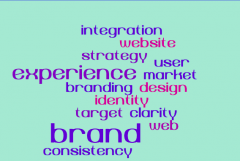Developing a seamless brand experience on your website takes time, patience, and a lot of tender loving care.
A effective web brand experience must be both well targeted and have uniform narrative woven across every customer touch point.
While there’s no sure-shot strategy to building and communicating a brand experience for high success rates, understanding and using a clear process helps to develop an immense amount of clarity and direction.
Alina Wheeler, a very well-known brand consultant, lays out the entire brand experience creation process in five succinct steps:
- Conduct research
- Clarify strategy
- Design identity
- Create touch points
- Manage assets
To build an effective brand experience isn’t easy, and as Wheeler states:
It requires an extraordinary amount of patience, an obsession with getting it right, and an ability to synthesize vast amounts of information.
This is true when using it to develop any brand collateral, especially a website.
Initial Analysis and Planning
There’s a school of thought in the industry that believes an organization’s brand is the most valuable asset they have. And that brand value is created through careful and constant nurturing and pruning.
Over time, your clientele begins to associate your product value with your brand, making it imperative for you to give your brand’s identity thoughtful consideration and the effort it deserves in building it and the website which translates it.
So, before you even start to think about building a new website you must clearly understand the messages you’d like to translate and the resources you have to do so.
Think about how you’d answer the following questions:
- What is my organization’s personality?
- Can I afford to be informal or do I need to maintain a certain formal “voice”?
- Do I have the right talent working with me to carry forward the design and the copywriting?
- How can I profile my audience?
- What do they expect from my site?
- Do I need to educate my audience or are they at a deeper end of the purchase cycle?
- Will they respond well to humor or do they need a more serious demeanor from my brand?
- What is my competition doing with their website?
- How can I frame and position my value proposition to gain an edge without imitating them?
Brand Experience Requires Clarity
Once you have solid, tangible answers to the questions above, zero in on the niche market you most want to communicate with through your website and target with your brand experience. Let’s take the digital marketing industry as a working example.
Because a large chunk of the population in nearly all business verticals has adopted digital marketing, the industry is saturated with service providers, many of whom claim to the best at what they do. How do you find a voice that’s uniquely yours and speaks above the clattering din?
The easiest way is to target a specific group of people.
- Who are the people your services best resonate with?
- Is there an industry or client profile that you work best with or have repeatedly had the most business from?
These are the people you want to target with your website and who you want to build your brand identity around. These are the customers who are looking for you and will benefit most from working with you.
Develop an Integrated User Experience
For normal branding activities, this is the point where you’d make decisions on details such as distribution channels, events, merchandise and offline events.
Because we’re talking about website branding here, you will still focus on these things but they must be considered in context of user experience.
- Begin with thinking about navigation and the information you’d like to share.
- How can you translate the feel and voice of your brand in the flow and presentation of content?
- How do you want a user to navigate your site? Where do you want them to go?
- How will a user come to your site?
- How can you quickly engage new users and continue to interact with return users?
- What type of content will you provide and how will you distribute it.
Your web design is a fundamental part of your brand experience, and in many ways is the symbol of your brand to your consumers (no matter what you do elsewhere).
Its ability to consistently reinforce your brand identity can make or break your outreach efforts, along with the rest of an integrated communications campaign.
Image credited by @lkpetrolino through worditout
